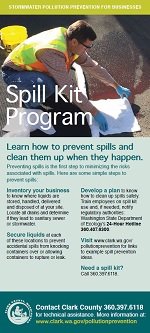Professional landscaping
Landscape management can create polluted storm runoff by moving soil, removing vegetation, watering, and applying
fertilizers, pesticides and herbicides. Rain and irrigation water can pick up stormwater pollutants such as toxic organic compounds, sediment, plant material and fertilizers and pesticides, and transport them to local streams.Professionals can reduce pollution by following Best Management Practices (BMPs) and implementing an Integrated Pest Management (IPM) plan tha considers cultural, mechanical, biological and chemical control methods. BMPs and IPM can also save time and money while reducing water pollution.
En Español - на русском
BMPs to prevent pollution
Clean up job site when finished. Only rain down the drain.
Sweep up dirt, fertilizers, mulch, clippings, and debris for disposal or composting when finished.
Clean tools and equipment on lawns or landscaped areas so runoff can infiltrate into soil.
Keep water on the landscape, not on hard surfaces where it can carry pollutants to the storm drain.
Dispose of chipped vegetation and clippings only at a permitted composting facility.
Integrated Pest Management
The most effective way to manage weed infestations is to use a combination of control methods specific to the problem weed, where it is in its growth-cycle, and the location where it is growing. This approach is called integrated pest management, or IPM, which uses cultural, mechanical, biological, and chemical (herbicide) control methods that treat the problem weed yet protect human health, habitat, water, and other natural resources.
Jardinería profesional
El mantenimiento de los jardines puede aumentar el escurrimiento pluvial al remover tierra, eliminar vegetación, regar y aplicar fertilizantes, pesticidas y herbicidas.
Los contaminantes del agua pluvial incluyen compuestos orgánicos tóxicos, metales pesados, aceites, sólidos suspendidos, bacterias, fertilizantes y pesticidas. El cuidado del césped y la vegetación puede incluir el control de hierbas, insectos, moho y bacterias desagradables.
Los profesionales pueden reducir el escurrimiento pluvial contaminado a través de un Plan Integral de Gestión de Plagas que considere métodos de control culturales, mecánicos, biológicos y químicos. Utilizar las mejores prácticas de gestión puede ahorrar tiempo y dinero al mismo tiempo que reduce la contaminación del agua.
A continuación, algunos consejos:
• Limpie la zona de trabajo cuando finalice su labor. Limpie la tierra, los fertilizantes, el abono, los pedazos de ramas y hierbas y los desechos con una escoba para tirarlos o utilizarlos como composta.
• Limpie las herramientas y el equipo sobre el césped o las áreas verdes.
• Barra el exceso de fertilizante, herbicida y hierba cortada hacia el césped o áreas verdes (nunca hacia la calle, la acera o superficies duras).
• Deseche la vegetación cortada solo en instalaciones de compostaje autorizadas.
• Mantenga el agua en las áreas verdes, no en las superficies duras.
Профессиональное обустройство ландшафта и озеленение
Управление ландшафтом может увеличить загрязнение ливневых стоков из-за снятия почвы, удаления растительного покрова, полива, применения удобрений, пестицидов и гербицидов.
Ливневые воды загрязняют токсические органические соединения, тяжелые металлы, масла, взвешенные твердые частицы, бактерии, удобрения и пестициды. Уход за газоном и растительностью может включать борьбу с нежелательными сорняками, насекомыми, плесенью и бактериями.
Специалисты могут уменьшить количество загрязненных стоков, придерживаясь Комплексного плана борьбы с вредителями, учитывающего культурные, механические, биологические и химические методы контроля. Наиболее эффективные методы могут также сэкономить время и деньги, уменьшая загрязнение воды.
Вот некоторые советы:
• Убирайте место проведения работ после их завершения. Сметайте грязь, удобрения, мульчу, щепки и органические остатки для утилизации или компостирования.
• Очищайте инструмент и оборудование над газоном или озелененными территориями.
• Сметайте излишек удобрений, гербицидов или скошенную траву на газоны и озелененные территории (не на улицу, тротуар или твердые поверхности).
• Утилизируйте обломки растительности только в разрешенных местах компостирования.
• Оставляйте воду на грунте, а не на твердых поверхностях.






